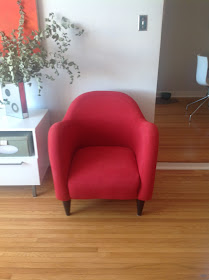 |
| Restored to its original color |
I've had this chair for more than a dozen years, and I still love it. Manufactured by Youngs Furniture in Portland, Maine, who source from local, artisanal furniture makers - it was holding up well. The foam was firm and still retained its shape. Only the color had faded, and this was accentuating stains and fabric pilling. Was it time to say goodbye to this little red chair?
Here is a close up of stains on the seat - can you see four bluish droplets? Probably red wine stains I missed long ago when the chair was new and the deeper color of the upholstery camouflaged them.
While over on the left side, the fabric was distressed and pilling.
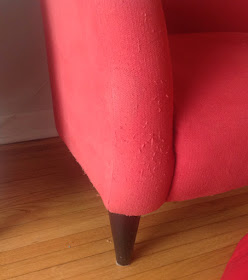 |
| Pet damage |
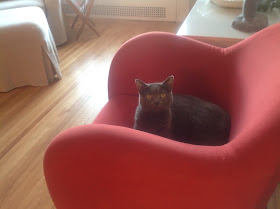 |
| Who, me? |
My first thought was to make a slipcover - I'd had such success with the white slipcover that I made for the settee. I purchased some red fabric, chalked the pattern, cut my main pieces, and sewed them together, only to realize as I was fitting the first round that slipcovers are just not the right style for this chair. They were making the chair look shabby chic - which is a style that I like very much, but not for this type of modern chair. I abandoned the slipcover idea.
I briefly considered reupholstery. I would want a similar fabric to the original - a wool-blend knit that hugged the chair's curves. I mused that it was really too bad that the color had faded, because the original scarlet is exactly the color I want now. In fact, I would want exactly the same fabric as the original if I could find it.
It was this line of thinking that led me to consider painting the chair.
Wha-what? I know, but people have done it!
Kristy over at Hyphen Interiors had great success painting her velvet wingback with a mixture of fabric medium and acrylic paint.
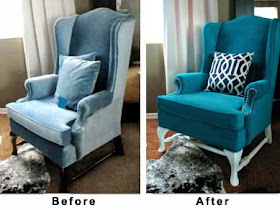 |
| Hyphen Interiors |
If you click on the "Chairs" link on her site, Kristy has assembled a library of before and afters from bloggers and readers, documenting successes and failures using the painting method.
One of the fails belongs to Sherry over at Young House Love. I've been following their blog for years, and I really appreciated Sherry's honest assessment (with photos!) about her painted chair fail. I could tell from Sherry's photo that I would not like the paint texture, which looked stiff, like fake leather.
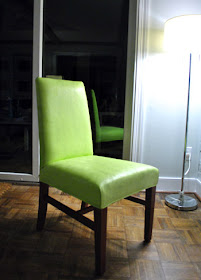 |
| Young House Love |
It was another photo on Kristy's Hyphen Interiors Chairs page that led me to Kara Paslay Designs and her post about dying a vintage chair using Rit dye.
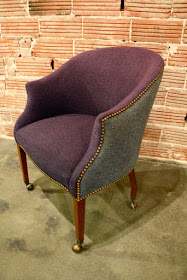 |
| Kara Paslay Designs |
Wow! Nice work, Kara.
First of all, don't you just love the lines of Kara's chair and the beautiful patina on the nails? I also love the fabric. And the color - both the faded blue original of the back and sides as well as the newly dyed purple front and seat. I applaud her decision to leave the chair two-toned. The colors look great together.
Of all the chairs that I have seen in my research, this one seems most like mine in terms of rounded shape and wool fabric. So I decided to give Rit dye a try.
If you are considering it too, a word of caution. Rit does not advise using their dye in this way:
"...we do not recommend dyeing upholstery as it is hard to fully rinse the dye from the upholstered fabric. If you would like to dye these items, we suggest testing the dye on a hidden area to see what color will be achieved."
If you read the comments on Kara's blog, many readers ask her about color transfer. Kara says that in her experience there was no color transfer and her chairs passed the "white t-shirt" challenge.
So, it's a risk. But it's a risk I am willing to take. I reason that if this doesn't work, I can still move on to Plan D - reupholstery.
My next step was to have the chair professionally shampooed. This faded the color a bit more, and it did not remove the wine stains. But at least I was now starting with a clean palette. I then used my sweater de-fuzzer from Brookstones on the area that had cat-claw damage - and I have to say this gave very good results!
 |
| Sweater de-fuzzer removes fabric pilling due to cat claw damage |
When I had the material as clean and smooth as I was going to get it, I assembled my supplies for the DIY dye job.
Supplies:
- Rit dye
- Scotch Guard fabric protector (not to be confused with Scotch Guard cleaner)
- Sponge brush
- Gloves
- Drop cloth
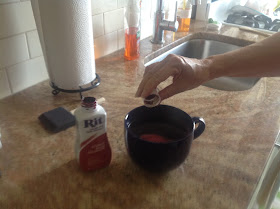 |
| I mixed the dye in a coffee mug that has a handle |
Step 1: Measure out a capful of dye and dissolve it in 12 ounces of hot water.
 |
| Paint Rit dye onto upholstery using downward strokes of your brush |
Step 2: Begin applying the dye to one area at a time using smooth strokes going in the same direction. I started on the back of the chair which is usually against the wall, reasoning that if it immediately looked bad I could stop. The back went well, so I continued, working my way around the chair panel by panel.
 |
| Brush Rit dye on upholstery one panel at a time |
This is what the chair looked like when I had finished one coat and it was still wet. At this point, it was not very encouraging. The drops of red wine stain stood out even more and looked very blue. I hoped that might change after it dried, so I carried on.
 |
| Chair after one coat of dye, still drying |
Step 3: Apply heat. I'm not sure how much this will actually help set the dye, but it can't hurt.
I didn't attempt to dry the chair with the hair dryer. I just ran hot air over every inch - especially the areas that make the most contact when a person is seated. I then left the chair to completely air dry overnight before starting a second coat of Rit dye the next day.
 |
| Heat from a hair dryer sets dye into upholstery |
Step 4: Spray thoroughly with Scotch Guard fabric protector. This step is also to help set the dye and keep it from rubbing off on people who use the chair. I applied two coats. I let the chair dry 24 hours between coats.
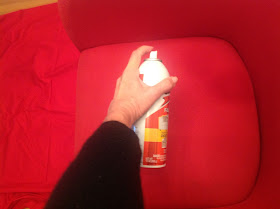 |
| Spray with Scotch Guard Fabric Protector |
Tip #1
You will need a drop cloth of some sort - I used a flattened piece of cardboard. Drips that got on our hardwood floors did not stain if I wiped them immediately. But I did get spatter on the white media center that I did not notice until after it had dried. It took a vigorous application of Mr. Clean Magic Eraser to get it off. Word.
Tip #2
I gave my chair two coats of dye, drying overnight between coats. I wanted a deeper saturation of color and I wanted to see if one more coat would better camouflage the red wine stains. The second coat did both.
Here is what the chair looked like with one coat in natural sunlight. Pretty good!
 |
| Chair after one coat of Rit dye and 24 hours of dry time |
The dye was doing a fairly good job of camouflaging the red wine stains.
 |
| The wine stain on the arm seems fainter after just one coat |
Tip #3
Pay attention to "nap".
If fabric has nap it will look darker when you brush your hand across it in one direction than the other. Velvet is known for its nap. My fabric is a wool-blend knit, so I didn't think that I had to worry about nap. However, I discovered after the first coat dried that I do.
 |
| Paint Rit dye on upholstery moving in one direction for smoothest coverage |
I prefer the look of the down brush stroke, so on the second coat I tried to apply all my brush strokes downward. As I finished each section, I went back over it again, brushing it all down one last time.
Here is what the chair looked like after two coats:
 |
| After two coats |
The color is now a deep, rich scarlet. The wine stains on the seat and right arm are almost undetectable and the cat claw damage on the left side is gone. The chair looks almost as good as new.






Excellent posting ! I’m anxious to try this myself to a faded old favorite chair !
ReplyDeleteThank you! I did have a plan B (reupholster) if it went wrong. Luckily, it went well. Six years later the chair still looks good!
DeleteThe Rit website mentions spraying the chair down with water after you've applied the dye. Any special reason why you skipped this step? They also mention using their 'dye fixative', did you consider using this in addition to the scotch guard? I'm just trying to formulate my plan here, thanks!
ReplyDeleteTwo reasons: 1. Rit actually says don't dye upholstered furniture (or that's what they were saying at the time) and 2. I really love the way Carla's purple chair turned out, so I followed what she did, and it worked! I do think a fixative would have been overkill. We've sat in the chair many times since and there's never been red transfer.
DeleteSo did you not wash off at all?? I’m about to attempt to dye my sofa using Rit but feeling nervous Incase it goes wrong! Thanks!
ReplyDeleteNo, I did not wash it off at all. I "set" the dye by drying it with a hairdryer.
Delete